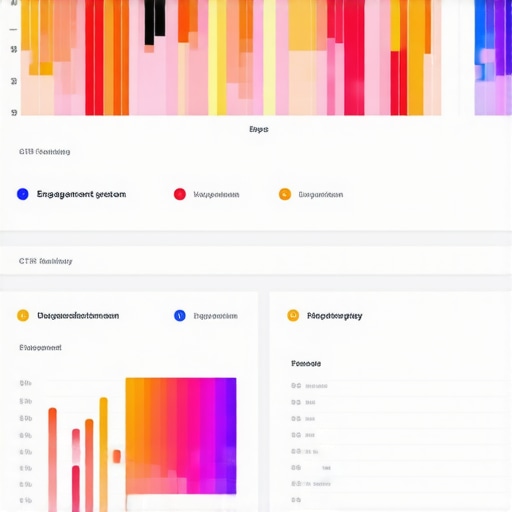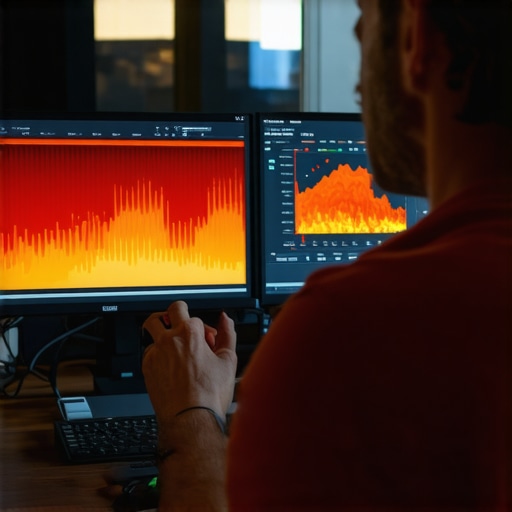Unlocking the Power of CTR Signals for Rapid Local SEO Success
In the competitive landscape of local search engine optimization, leveraging Click-Through Rate (CTR) signals has transitioned from a peripheral tactic to a core driver of Google My Business (GMB) ranking acceleration. As digital marketers and local business owners seek to outperform rivals swiftly, understanding and harnessing proven CTR signal techniques becomes paramount for achieving rapid visibility and customer engagement.
Semantic SEO and the Evolution of CTR Signal Optimization
Semantic SEO, emphasizing contextually relevant content and intent-matching keywords, enhances how search engines interpret CTR signals within the broader ecosystem of local ranking factors. Advanced practitioners recognize that CTR optimization is not merely about enticing clicks but about aligning content strategies with nuanced search intent, thereby boosting engagement metrics that translate into higher rankings. For instance, implementing structured data markup and schema can significantly improve snippet visibility, catalyzing CTR improvements.
Expert Insights: The Nuanced Role of CTR in Local Rankings
Research from authoritative sources such as Moz’s Local Search Ranking Factors underscores that CTR signals, combined with review quality, NAP consistency, and user engagement, form a complex matrix influencing local rankings. The key lies in integrating CTR strategies with comprehensive local SEO audits, continuously refining tactics based on real-time analytics, and understanding that CTR is both a cause and effect within the ranking algorithm.
What Are the Most Advanced Techniques to Maximize CTR Signals?
How can local businesses leverage AI-driven insights to refine CTR strategies effectively?
AI and machine learning tools enable granular analysis of user behavior patterns and search trends, facilitating hyper-targeted content and ad placements. Implementing dynamic snippets, personalized call-to-actions, and localized schema markup can substantially improve CTR. For example, using predictive analytics to identify high-conversion keywords allows businesses to tailor their GMB posts and website content for maximal engagement, directly influencing ranking velocity.
Integrating CTR Signal Tactics into a Broader Local SEO Framework
Strategic integration involves synchronizing CTR optimization with local reviews, citation consistency, and on-page SEO. For example, enhancing GMB profiles with optimized images, videos, and timely responses to reviews not only improves user trust but also amplifies CTR signals. Combining these efforts with backlink strategies and authoritative content curation establishes a resilient local SEO ecosystem.
For those interested in deepening their mastery, exploring comprehensive CTR signal techniques for local ranking growth provides actionable insights to accelerate results. Additionally, engaging with industry forums and sharing experiential insights can foster innovative approaches tailored to specific niche markets.
As the landscape continues to evolve, continuous testing and adaptation remain essential. The most successful practitioners view CTR signals not as a static metric but as a dynamic, integral part of an advanced, data-driven local SEO strategy.
Harnessing Behavioral Data to Elevate CTR Signals
In the quest for rapid local SEO growth, understanding user behavior patterns provides a competitive edge. Advanced practitioners leverage analytics platforms like Google Analytics and Hotjar to dissect how visitors interact with GMB listings and website content. By identifying high-engagement keywords, preferred call-to-actions, and optimal posting times, businesses can tailor their CTR strategies for maximum impact. For example, utilizing heatmaps to analyze where users click most frequently helps refine visual elements and messaging, ultimately boosting CTR.
Can You Quantify the Impact of Micro-Optimizations on CTR?
Absolutely. Small yet strategic adjustments—such as optimizing image thumbnails, crafting compelling meta descriptions, or experimenting with localized schema markup—can significantly influence click behavior. A comprehensive study by Backlinko highlights that even minor enhancements to titles and snippets can lead to double-digit increases in CTR, translating directly into improved local rankings. These micro-optimizations, when systematically implemented and tested, become powerful levers in the local SEO toolkit.
Expert Insights: The Intersection of User Experience and CTR Optimization
According to industry authority Moz, user experience (UX) plays a pivotal role in sustaining high CTR levels. A seamless, mobile-friendly interface coupled with fast-loading pages and intuitive navigation encourages users to click through and engage further. Integrating UX principles with CTR-focused tactics—like clear, concise messaging and visually appealing elements—creates a holistic approach that accelerates local ranking growth. For a deeper dive into UX-driven SEO, explore this guide on CTR signal strategies.

How can automation tools help in refining CTR strategies at scale?
Automation platforms like SEMrush or Ahrefs enable continuous A/B testing of snippets, titles, and images across multiple listings and keywords, providing real-time data to inform adjustments. These tools can also automate monitoring of CTR fluctuations, alerting marketers to emerging opportunities or issues. By systematically deploying automation, local businesses can maintain a dynamic, data-driven approach that sustains high CTR levels and accelerates ranking momentum.
Actionable Next Steps for Local Marketers
If you’re eager to deepen your mastery over CTR signals, consider implementing a structured testing framework that tracks the impact of each micro-optimization. Regularly audit your GMB profile for updates, optimize your visual assets, and schedule consistent content refreshes aligned with user search intent. For expert-level insights and proven tactics, visit this resource on CTR signal tactics. Remember, the key to sustained local SEO success lies in a relentless focus on data, user experience, and strategic experimentation.
Harnessing Behavioral Analytics for High-Impact CTR Improvements
To truly master CTR signals, a granular understanding of user behavior is essential. Beyond basic metrics, sophisticated tools like Google Analytics and Hotjar reveal nuanced engagement patterns, such as scroll depth, interaction heatmaps, and session recordings. These insights enable marketers to identify precisely which elements—be it headlines, images, or call-to-actions—resonate most with their target audience. For example, heatmaps often uncover unexpected click zones, guiding redesigns that significantly enhance CTR.
What is the role of predictive analytics in preemptively optimizing CTR?
Predictive analytics harness historical data to forecast future user behaviors, allowing businesses to proactively tailor their snippets and content. By analyzing trends and seasonal patterns, companies can adjust their GMB posts and meta descriptions to align with upcoming search queries, boosting the likelihood of clicks before competitors react. This approach transforms CTR optimization from reactive to strategic, leveraging machine learning algorithms like those integrated into platforms such as SEMrush.
Micro-Optimizations: Tiny Tweaks, Massive Impact
Research indicates that micro-optimizations, often overlooked, can yield double-digit increases in CTR. These include refining image thumbnails for better visual appeal, crafting compelling meta descriptions that evoke curiosity, and structuring schema markup to enhance snippet visibility. For instance, updating listing images to align with seasonal themes or trending topics can make your GMB profile stand out amidst competitors.

How does schema markup influence snippet appearance and CTR?
Schema markup provides search engines with explicit context about your business, enabling enhanced snippets such as star ratings, event details, or product information. These rich snippets capture user attention and elevate CTR by offering more informative previews. According to a study by Search Engine Journal, implementing schema markup can increase CTR by up to 30%, especially in competitive local searches.
Integrating User Experience (UX) Principles for Sustained CTR Growth
High CTR is not solely about attracting clicks; it also depends on delivering a seamless user experience post-click. Mobile responsiveness, fast-loading pages, and intuitive navigation keep visitors engaged and reduce bounce rates. Combining UX best practices with CTR-focused content—such as clear, concise headlines and visually appealing elements—creates a feedback loop that boosts both engagement and rankings.
How can A/B testing refine your CTR strategies effectively?
A/B testing enables marketers to compare variations of snippets, images, and CTAs to determine which elements drive higher CTRs. Continuous experimentation allows for data-driven decisions, reducing guesswork. Platforms like Unbounce facilitate rapid testing cycles, helping local SEO practitioners optimize their listings iteratively for maximum impact.
Future-Proofing Your CTR Strategy with Automation and AI
Automation tools such as SEMrush, Ahrefs, and BrightLocal streamline the process of monitoring CTR fluctuations across multiple listings and keywords. These platforms can automatically suggest adjustments and even execute A/B tests, saving time and increasing precision. Moreover, integrating AI-driven insights—like natural language processing to analyze review sentiments—can inform content tweaks that resonate more deeply with your audience, further elevating CTR.
If you’re committed to staying ahead in local SEO, adopting these advanced CTR optimization techniques is crucial. Dive deeper into industry-specific case studies and expert guides to refine your approach continually, ensuring sustained visibility and competitive advantage in local search rankings.
Harnessing Behavioral Analytics for Cutting-Edge CTR Optimization
In the realm of local SEO, delving into granular behavioral analytics unlocks unprecedented opportunities to refine CTR signals with surgical precision. Leveraging sophisticated tools such as Google Analytics and Hotjar reveals intricate engagement patterns—scroll depths, interaction heatmaps, and session recordings—that illuminate how users interact with your GMB listings and website content. This nuanced understanding enables marketers to craft hyper-targeted content and visual elements that resonate deeply with their audience, significantly elevating CTR and driving local rankings upward.
Can Predictive Analytics Foresee User Intent and Preemptively Enhance CTR?
Predictive analytics, empowered by machine learning algorithms, analyze historical and real-time data to forecast future user behaviors and search trends. By identifying seasonal patterns and emerging queries, businesses can proactively tailor their snippets, meta descriptions, and GMB posts to match anticipated search intent. This strategic foresight transforms CTR optimization from reactive adjustments to a preemptive, data-driven approach that positions your brand ahead of competitors, ensuring higher click-through rates and accelerated local ranking gains. Platforms like SEMrush offer robust predictive capabilities that facilitate this advanced level of optimization.
Micro-Optimizations with Macro-Impact: Tiny Tweaks for Massive Gains
Research consistently demonstrates that micro-optimizations—such as refining image thumbnails, crafting compelling meta descriptions, and implementing structured schema markup—can lead to double-digit increases in CTR. For example, updating listing images to align with current seasonal themes or trending topics can make your GMB profile stand out amidst competitors. Applying schema markup enhances snippet visibility by adding star ratings, product details, or event information, which significantly attracts user attention. According to a study by Search Engine Journal, such micro-tweaks can boost CTR by up to 30%, particularly in competitive local searches.

How does Structured Data Markup Elevate Your Snippet’s Appeal and CTR?
Schema markup provides explicit context about your business to search engines, enabling the display of enriched snippets—such as star ratings, event details, or product information—that capture user attention more effectively. Rich snippets not only enhance visibility but also convey trustworthiness and relevance, which are critical in local search contexts. Implementation of schema markup has been shown to increase CTR by up to 30%, as evidenced by industry research, making it an indispensable component of advanced local SEO strategies.
Integrating UX Principles for Sustainable CTR Growth
High CTR is intrinsically linked to delivering an exceptional user experience (UX). Mobile responsiveness, fast-loading pages, and intuitive navigation foster trust and encourage users to engage further. Merging UX best practices with CTR-focused tactics—such as clear, concise headlines, visually appealing design, and strategic placement of call-to-actions—creates a virtuous cycle that amplifies both engagement and rankings. For an in-depth exploration, see this comprehensive guide on CTR strategies and UX integration.
Expert Insights & Advanced Considerations
1. Emphasize Data-Driven Personalization
Harnessing behavioral analytics and predictive models enables hyper-targeted content, significantly boosting CTR by aligning with user intent and seasonal trends.
2. Integrate Schema Markup for Enhanced Snippets
Implementing structured data not only improves snippet visibility but also elevates trust and relevance, leading to higher click-through rates especially in competitive local searches.
3. Prioritize UX for Post-Click Engagement
A seamless user experience—fast loading, mobile responsiveness, and intuitive navigation—sustains high CTR’s impact on rankings and encourages further engagement.
4. Automate Testing and Monitoring
Utilize automation tools for continuous A/B testing of snippets, images, and call-to-actions, enabling rapid iteration and optimization at scale.
5. Leverage AI for Content Optimization
AI-driven insights facilitate real-time adjustments to meta descriptions, headlines, and visual assets, ensuring your listings remain compelling and competitive.
Curated Expert Resources
- Google’s Rich Results Test: Essential for validating schema markup and rich snippets to maximize visual appeal and CTR.
- Moz’s Local Search Ranking Factors: Provides authoritative insights into ranking signals, including CTR’s nuanced role within the local SEO ecosystem.
- Hotjar: Advanced behavioral analytics tool that reveals user interaction patterns, informing micro-optimizations for CTR.
- SEMrush AI-Driven Content Assistant: Supports predictive analytics and content suggestions to preemptively enhance CTR strategies.
- GMBfaster.com Resources: Offers specialized strategies and case studies on rapid local ranking growth through CTR signals.
Final Expert Perspective
Mastering CTR signals for local SEO in 2024 demands a sophisticated blend of data-driven personalization, technical enhancements like schema markup, and seamless user experiences. These high-level insights, reinforced by authoritative resources, empower professionals to craft resilient, scalable strategies that accelerate rankings and deepen engagement. For those committed to staying at the forefront, continuous experimentation with AI and behavioral analytics isn’t optional but essential. Engage with these resources, refine your tactics relentlessly, and let your expertise elevate your local search presence to new heights.

